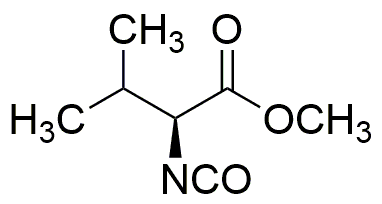Methyl (S)-(-)-2-isocyanato-3-methylbutyrate is widely utilized in research focused on:
- Pharmaceutical Development: This compound serves as an important intermediate in the synthesis of various pharmaceuticals, particularly in the production of drugs that target specific biological pathways.
- Agricultural Chemicals: It is used in the formulation of agrochemicals, enhancing the efficacy of pesticides and herbicides by improving their ability to penetrate plant tissues.
- Polymer Chemistry: The compound acts as a building block for creating specialty polymers with unique properties, making it valuable in the production of coatings and adhesives.
- Biochemical Research: Researchers utilize this isocyanate in studies related to protein modification, which can help in understanding enzyme mechanisms and developing enzyme inhibitors.
- Material Science: It is applied in developing advanced materials, such as foams and composites, due to its ability to enhance mechanical properties and thermal stability.
General Information
Properties
Safety and Regulations
Applications
Methyl (S)-(-)-2-isocyanato-3-methylbutyrate is widely utilized in research focused on:
- Pharmaceutical Development: This compound serves as an important intermediate in the synthesis of various pharmaceuticals, particularly in the production of drugs that target specific biological pathways.
- Agricultural Chemicals: It is used in the formulation of agrochemicals, enhancing the efficacy of pesticides and herbicides by improving their ability to penetrate plant tissues.
- Polymer Chemistry: The compound acts as a building block for creating specialty polymers with unique properties, making it valuable in the production of coatings and adhesives.
- Biochemical Research: Researchers utilize this isocyanate in studies related to protein modification, which can help in understanding enzyme mechanisms and developing enzyme inhibitors.
- Material Science: It is applied in developing advanced materials, such as foams and composites, due to its ability to enhance mechanical properties and thermal stability.
Documents
Safety Data Sheets (SDS)
The SDS provides comprehensive safety information on handling, storage, and disposal of the product.
Product Specification (PS)
The PS provides a comprehensive breakdown of the product’s properties, including chemical composition, physical state, purity, and storage requirements. It also details acceptable quality ranges and the product's intended applications.
Certificates of Analysis (COA)
Search for Certificates of Analysis (COA) by entering the products Lot Number. Lot and Batch Numbers can be found on a product’s label following the words ‘Lot’ or ‘Batch’.
*Catalog Number
*Lot Number
Certificates Of Origin (COO)
This COO confirms the country where the product was manufactured, and also details the materials and components used in it and whether it is derived from natural, synthetic, or other specific sources. This certificate may be required for customs, trade, and regulatory compliance.
*Catalog Number
*Lot Number
Safety Data Sheets (SDS)
The SDS provides comprehensive safety information on handling, storage, and disposal of the product.
DownloadProduct Specification (PS)
The PS provides a comprehensive breakdown of the product’s properties, including chemical composition, physical state, purity, and storage requirements. It also details acceptable quality ranges and the product's intended applications.
DownloadCertificates of Analysis (COA)
Search for Certificates of Analysis (COA) by entering the products Lot Number. Lot and Batch Numbers can be found on a product’s label following the words ‘Lot’ or ‘Batch’.
*Catalog Number
*Lot Number
Certificates Of Origin (COO)
This COO confirms the country where the product was manufactured, and also details the materials and components used in it and whether it is derived from natural, synthetic, or other specific sources. This certificate may be required for customs, trade, and regulatory compliance.


